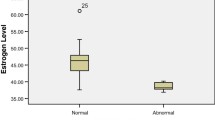Abstract
Women generally exhibit angina rather than myocardial infarction as the first manifestation of heart disease. Postmenopausal use of hormone replacement therapy, specifically estrogens, is associated with reduced incidence of major cardiac events suggesting estrogen may protect the heart during ischemia. We recently showed that acute administration of conjugated equine estrogens prior to ischemia attenuated the ventricular arrhythmias of ischemia as well as those of reperfusion. This study looks at basal effects of estrogen on coronary blood flow and the effects of estrogen on regional blood flow during ischemia to determine if estrogen exerts its antiarrhythmic effects during ischemia by altering blood flow.
Under conditions of natural blood flow, estrogen caused cyclic changes in blood flow. When coronary blood flow was controlled and limited, estrogen increased coronary perfusion pressure (118±8 mmHg vs. 85±10 mmHg in non-treated dogs, P<0.05) demonstrating an overall vasoconstrictor effect. Coronary blood flow and regional myocardial perfusion were determined before and during ischemia in anesthetized dogs with and without acutely-administered estrogen. Colored microspheres were injected at steady state prior to ischemia, and during steady state myocardial ischemia. Conjugated equine estrogen (10 μg/kg), administered about 6 min before ischemia, had no effect on regional perfusion under steady state conditions, nor in the non-ischemic zone during ischemia. Perfusion in the subepicardial and subendocardial ischemic zones in estrogen-treated dogs was significantly lower than in non-treated dogs [0.14±0.01 ml/min/g vs. 0.23±0.02 ml/min/g (P<0.05) in the epicardial ischemic zone; and, 0.15±0.02 ml/min/g vs. 0.22±0.03 ml/min/g (P<0.05) in the endocardial ischemic zone].
We conclude that the acute, systemic administration of estrogen in the anesthetized dog decreases regional perfusion in the ischemic myocardium and causes significant coronary vasoconstriction when flow is controlled and limited.
Similar content being viewed by others
Author information
Authors and Affiliations
Additional information
Received: 3 March 1998, Returned for 1. revision: 28 April 1998, 1. Revision received: 29 May 1998, Accepted: 18 June 1998
Rights and permissions
About this article
Cite this article
McHugh, N., Solowiej, A., Klabunde, R. et al. Acute coronary vascular and myocardial perfusion effects of conjugated equine estrogen in the anesthetized dog. Basic Res Cardiol 93, 470–476 (1998). https://doi.org/10.1007/s003950050117
Issue Date:
DOI: https://doi.org/10.1007/s003950050117




